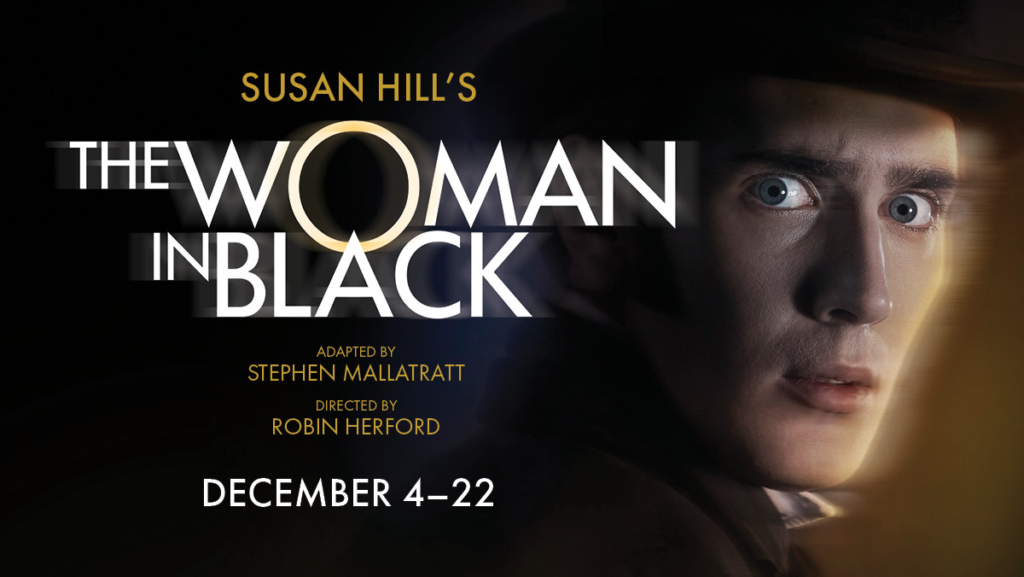
By Martin Morse Wooster: Washington’s Shakespeare Theatre has two stages to fill and produces about six plays a year on their own, so they’re happy to stage worthwhile travelling productions from Great Britain. Last year, they were the home for An Inspector Calls, a play by J.B. Priestley that has been running in London for around 20 years but was making its first American tour.
This December, the Shakespeare Theatre hosted a travelling production of The Woman in Black by Stephen Mallatratt, based on a novel by Susan Hill.[1] This play has been performed in London since June 1989, and is the second longest running show in the West End (behind The Mousetrap). The American production was in Pasadena in November and will be in New York in January, performed in a pub with beer and pub snacks available.
There’s a reason why The Woman in Black is so popular. It’s a highly effective and entertaining play that I was glad made its way to Washington.
The play had its origins in the late 1980s. Robin Herford was running a small theater in a small town in England, and had 5,000 pounds in grant money he wanted to use by the end of the year. Herford wanted a holiday production that wasn’t A Christmas Carol or a pantomime, and asked Stephen Mallatratt, the theatre’s resident playwright, to come up with something that had a ghost in it and could be performed by no more than four actors, which was the limit of the theater’s budget. Mallatratt proposed adapting The Woman in Black, and beat the budget limitations by boiling down four characters to two.
“What surprised us was that this play actually scared people,” Herford said in an interview with the Washington Post, “Long-running play ‘The Woman in Black’ comes to the Shakespeare Theatre Company”, “We had thought people would like it much as they enjoy Halloween, without really believing it. I didn’t expect people to take a ghost story seriously, because it’s notoriously difficult to scare people in a theater. We weren’t looking to do that; it just sort of happened.”
The story tells about Mr. Kipps, who shows up at a theater with a play based on his experiences. The other character, who is called “The Actor,” flips through the manuscript and says it will take five hours to perform—longer than King Lear. So he tells Kipps they’ll read through the manuscript; he’ll play Kipps, and Kipps can take over all the other parts. He shows Kipps a basket and explains how the basket can be used to stand in for all sorts of things.
Kipps begins by bumbling and stumbling and we get several good acting jokes. Then about 15 minutes into the production we leave our world and enter Kipps’s story.
The story is that Kipps, sometime in the past, is a lawyer who is probating a will of an old woman who lives on a huge mansion on an island that’s so remote that it can only be reached by a causeway that floods at high tide. Kipps spends several nights on this remote island, and learns that the island is haunted. But who is the ghost, and what does the ghost want?

The Woman in Black is theatre of the mind, which is very easy to do badly. This fall I saw a production by the Washington Stage Guild of an adaptation of Charles Dickens’s Hard Times, in which we were promised four actors would play dozens of parts. They indeed did this but the production droned. It was an audiobook, and not a good one.
The Woman in Black uses all the tools theatre has, including excellent use of sound. I couldn’t find a sound credit, but Kevin Sleep did the lighting, and he was very good.
In the production I saw, Daniel Easton played The Actor and Robert Goodale played Kipps. Both were fine in their parts.
One final note. If you are a novelist who is thinking of having her books turned into audiobooks, you need to see this show. In particular, pay close attention to the scenes involving Spider, a dog who serves as Kipps’s companion and who doesn’t exist. The scenes with Spider were the tensest of the evening. If you see this, think about why the scenes with Spider were so exciting—and you might come up with ways to make your readers more involved in the story you’re telling.
The Woman in Black is highly entertaining and I heartily recommend it.
[1] The Woman in Black has also been the basis for two films, most recently a 2012 production starring Daniel Radcliffe.
Discover more from File 770
Subscribe to get the latest posts sent to your email.

We saw the play some years ago in a local theater and we were TERRIFIED.